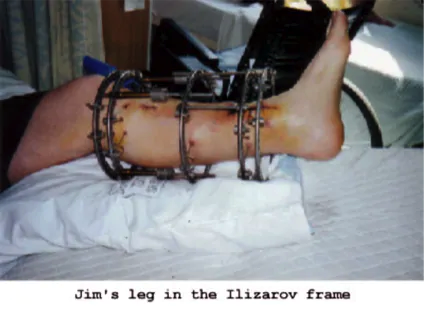Jim's Story - Combined Therapy in Post Surgical Recovery
A case Study by Zakia Collins
This article is taken from the website of the West London School of Therapeutic Massage
This article is taken from the website of the West London School of Therapeutic Massage
In the summer of 1997, my husband Jim had a climbing accident.
He has been falling off motorbikes all our married life, and has so many plates and pins that he's nearly bionic! This was the first time he'd fallen off rocks.
He broke the main bone in his lower leg - the tibia - and needed an operation to put metal plates in it.
Which should have been the end of the story.
The problem was that Jim reacted to the metal, and the leg refused to heal.
The wound kept weeping and he was continually in pain. Month after month of wide spectrum antibiotics seemed to make no difference.
After 2 years of regular attendance at the local hospital we decided to seek a second opinion.
It took the Harley Street specialist a few moments to diagnose that the leg was still broken.
Further tests then showed that he had serious osteo-myelitis. "Bacteria have taken up residence in the bone and are slowly gnawing it away', said the specialist.
Jim has never been big on complementary therapies. By now, however, he was willing to try anything.
I had been maintaining his leg using a combination of therapies.
Despite heavy doses of painkillers and sleeping tablets, he was not sleeping.
To enable him to sleep and to cope with pain during this period, I used CranioSacral therapy several times a day, and gave him frequent massages with oils such as chamomile and sandalwood.
Because the leg was the size of a football, and the skin was severely stretched, we used lymph drainage techniques to manage the build up of fluids.
The crunch came following a flight to New York.
The fluid had accumulated over the area, and had built up into a golf-ball sized lump.
Sitting in a beautiful white bathroom in our son's apartment, the wound exploded, showering everywhere with blood.

On arrival back in the UK, we went to see PJ Cousin, a talented acupuncturist and Chinese herbalist, and a family friend. PJ felt the situation was extremely serious. As he said at the time: "the last time I saw a leg this colour, I sent the gentleman in a taxi to hospital, where they amputated it".
This gave Jim food for thought! PJ made a powerful synergy of strong essential oils which he applied as a dressing. As he predicted, within 24 hours the whole leg started to weep like a mountain stream, from knee to ankle. And it stank.
To drain the wound fully, PJ proposed a programme of soaks and poultices using salt, clay and essential oils. In addition we used chamomile hydrolat (flower water') to sooth the area, which was raw and inflamed. I continued to use CranioSacral techniques on a daily basis, to help Jim rest and sleep and manage his pain. I also gave him bed-time neck massages with macerated hypericum to stop him getting too depressed.
Once the wound had drained and was clean, the Harley Street specialist confirmed that the leg would not completely heal while the bacteria were still present.
Antibiotics would not do the job: A radioactive bone scan confirmed this. The infected area of bone and surrounding tissue needed to be cut out. Jim would then have to spend 18 months to two years in an Ilizarov frame.
These frames look like an instrument of torture. They are made up of 5 titanium discs, held in place by titanium pins. They surround the leg, in Jim's case running from knee to ankle, and they extend out from it by some 2-3 inches all round. The purpose is to stretch and compress the bone and tissue to allow the bone to re-form once the diseased area has been cut out. Jim lost about 2 inches of both the tibia and fibula above the ankle so the frame had some work to do.
This gave Jim food for thought! PJ made a powerful synergy of strong essential oils which he applied as a dressing. As he predicted, within 24 hours the whole leg started to weep like a mountain stream, from knee to ankle. And it stank.
To drain the wound fully, PJ proposed a programme of soaks and poultices using salt, clay and essential oils. In addition we used chamomile hydrolat (flower water') to sooth the area, which was raw and inflamed. I continued to use CranioSacral techniques on a daily basis, to help Jim rest and sleep and manage his pain. I also gave him bed-time neck massages with macerated hypericum to stop him getting too depressed.
Once the wound had drained and was clean, the Harley Street specialist confirmed that the leg would not completely heal while the bacteria were still present.
Antibiotics would not do the job: A radioactive bone scan confirmed this. The infected area of bone and surrounding tissue needed to be cut out. Jim would then have to spend 18 months to two years in an Ilizarov frame.
These frames look like an instrument of torture. They are made up of 5 titanium discs, held in place by titanium pins. They surround the leg, in Jim's case running from knee to ankle, and they extend out from it by some 2-3 inches all round. The purpose is to stretch and compress the bone and tissue to allow the bone to re-form once the diseased area has been cut out. Jim lost about 2 inches of both the tibia and fibula above the ankle so the frame had some work to do.
The frame brought its own complications. It's a cage, which you can never remove - for example at night. The pins push into live flesh. Even the smallest movement can tear the tissue. Jim's body reacted to the pins, treating them as foreign bodies. His leg would swell and the skin would become tight and raw. He was in constant pain, and we sometimes wondered how he would get through it. He had become addicted to the painkillers and sleeping tablets and was very depressed. When he tried to stop the tablets, he went ‘cold turkey'. I had already been using neroli and pettigrain. Now I increased the dosage, and the frequency of the massages and the CranioSacral treatments.
Extreme pain and continuous infection at the site of the pins are common experiences for most patients using an Ilizarov frame. We used lymph drainage twice daily to drain the swollen lymph nodes in his groin, and gave him a daily foot and ankle massage with macerated hypericum and juniper to keep the ankle mobile. We also used large amounts of tea tree in chamomile hydrolate to keep the sites of the holding pins clean and prevent them becoming infected.
Jim was in the frame for 15 months. Overall it took four years for the wound to heal completely and for the leg bone to re-grow. And this was a simple fracture!. Today, the leg is strong and the scarring is minimal. You can barely see the pin marks. He is back climbing and biking. He was such a star' patient that, for some time after the frame was removed, the hospital asked him to talk to other patients who were considering having a frame. This was a clear example of natural therapies working hand in hand with allopathic medicine to produce a great result. But both approaches were needed. As Jim puts it, ˜without complementary therapies I literally wouldn't have a leg to stand on'.
Zakia Collins is principal of WLSTM.
PJ Cousin is a licensed acupuncturist and practitioner of natural therapies.
Extreme pain and continuous infection at the site of the pins are common experiences for most patients using an Ilizarov frame. We used lymph drainage twice daily to drain the swollen lymph nodes in his groin, and gave him a daily foot and ankle massage with macerated hypericum and juniper to keep the ankle mobile. We also used large amounts of tea tree in chamomile hydrolate to keep the sites of the holding pins clean and prevent them becoming infected.
Jim was in the frame for 15 months. Overall it took four years for the wound to heal completely and for the leg bone to re-grow. And this was a simple fracture!. Today, the leg is strong and the scarring is minimal. You can barely see the pin marks. He is back climbing and biking. He was such a star' patient that, for some time after the frame was removed, the hospital asked him to talk to other patients who were considering having a frame. This was a clear example of natural therapies working hand in hand with allopathic medicine to produce a great result. But both approaches were needed. As Jim puts it, ˜without complementary therapies I literally wouldn't have a leg to stand on'.
Zakia Collins is principal of WLSTM.
PJ Cousin is a licensed acupuncturist and practitioner of natural therapies.

